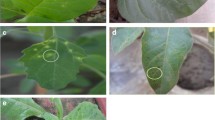Abstract
Pepino mosaic virus (PepMV) disease causes important losses in tomato (Solanum lycopersicum) yield around the world. In order to find new sources of resistance to this virus, a collection of accessions from different relatives of tomato was screened against PepMV infection. All accessions of S. peruvianum were 100% systemically infected and showed the characteristic disease symptoms. Although some accessions of S. peruvianum contained low concentrations of the virus, the associated symptoms were moderate to severe. In two accessions of S. chilense, some plants with low virus concentration and without symptoms were detected. Accessions of S. lycopersicoides performed best. A variable percentage of plants developed systemic symptoms. All plants of four accessions of S. lycopersicoides, and some selected plants of three more accessions, remained free of PepMV infection. This indicates that S. lycopersicoides is the most promising source of resistance to PepMV and its use in breeding programmes may allow the development of commercial varieties of tomato resistant to PepMV.
Similar content being viewed by others
References
Aparicio F, Soler S, Aramburu J, Galipienso L, Nuez F, Pallás V & López C, 2009. Simultaneous detection of six RNA plant viruses affecting tomato crops using a single digoxigenin- labelled polyprobe. Eur J Plant Pathol 123, 117–123.
Canady MA, Meglic V & Chetelat R, 2005. A library of Solanum lycopersicoides introgression lines in cultivated tomato. Genome 48, 685–697.
Clark MF & Adams AN, 1977. Characteristics of the microplate method of enzyme-linked immunosorbent assay (ELISA) for the detection of plant viruses. J Gen Virol 34, 475–483.
Díez MJ & Nuez F, 2008. Tomato. In: Prohens, J & Nuez, F (Eds.): Handbook of plant breeding: Vegetables II. Springer, New York. 249–323.
EPPO (European and Mediterranean Plant Protection Organization), 2010. Pepino mosaic virus. http://www.eppo.org/QUARANTINE/Alert_List/viruses/PEPMV0.htm. Consulted 22 Dec. 2010.
Fakhro A, van Bargen S, Bandte M, Büttner C, Franken P & Schwarz D, 2011. Susceptibility of different plant species and tomato cultivars to two isolates of Pepino mosaic virus. Eur J Plant Pathol 129, 579–590.
Gómez P, Sempere RN, Elena SF & Aranda MA, 2009. Mixed infections of Pepino mosaic virus strains modulate the evolutionary dynamics of this emergent virus. J Virol 83, 12378–12387.
Hanssen IM & Thomma BPHJ, 2010. Pepino mosaic virus: a successful pathogen that rapidly evolved from emerging to endemic in tomato crops. Mol Plant Pathol 11, 179–189.
Hanssen IM, van Esse HP, Ballester AR, Hogewoning SW, Parra NO, Paeleman A, Lievens B, Bovy AG & Thomma BPHJ, 2011. Differential tomato transcriptomic responses induced by Pepino mosaic virus isolates with different aggressiveness. Plant Physiol 156, 301–308.
Jones RAC, Koening R & Lesemann DE, 1980. Pepino mosaic virus, a new potexvirus from pepino (Solanum muricatum). Ann Appl Biol 94, 61–68.
Ling KS & Scott JW, 2007. Sources of resistance to Pepino mosaic virus in tomato accessions. Plant Dis 91, 749–753.
López C, Soler S & Nuez F, 2005. Comparison of the complete sequences of three different isolates of Pepino mosaic virus: Size variability of the TGBp3 protein between tomato and L. peruvianum isolates. Arch Virol 150, 619–627.
Miller JC & Tanksley SD, 1990. RFLP analysis of phylogenetic relationships and genetic variation in the genus Lycopersicon. Theor Appl Genet 80, 437–448.
Picó B, Herraiz J, Ruiz JJ & Nuez F, 2002. Widening the genetic basis of virus resistance in tomato. Sci Hort 94, 73–89.
Shipp JL, Buitenhuis R, Stobbs L, Wang K, Kim WS & Ferguson G, 2008. Vectoring of Pepino mosaic virus by bumble-bees in tomato greenhouses. Ann Appl Biol 53, 149–155.
Soler-Aleixandre S, López C, Cebolla-Cornejo J & Nuez F, 2007. Sources of resistance to Pepino mosaic virus (PepMV) in tomato. Hortscience 42, 40–45.
Soler-Aleixandre S, López C, Díez MJ, Pérez-De Castro A & Nuez F, 2005. Association of Pepino mosaic virus with tomato collapse. J Phytopathol 153, 1–6.
Zhao LX, Qiu CX, Li JF, Chai YR, Kai GY, Li ZG, Sun XF & Tang KX, 2005. Investigation of disease resistance and cold tolerance of Solanum lycopersicoides for tomato improvement. Hortscience 40, 43–46.
Zitikaite I, Staniulis J, Jomantiene R & Petniunas P, 2004. Molecular and immunoelectron microscopic identification of Pepino mosaic potexvirus in tomato fruits imported from Spain. Botanica Lithuanica 10, 89–98.
Author information
Authors and Affiliations
Corresponding author
Rights and permissions
About this article
Cite this article
Soler, S., López, C., Prohens, J. et al. New sources of resistance to PepMV in tomato. J Plant Dis Prot 118, 149–155 (2011). https://doi.org/10.1007/BF03356397
Received:
Accepted:
Published:
Issue Date:
DOI: https://doi.org/10.1007/BF03356397




